In Memoriam
James J. Duderstadt
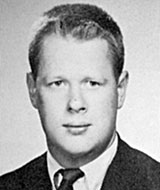
Jim Duderstadt
1964 Yale graduation
Jim Duderstadt died on August 21, 2024. The following remembrances are included here:
- Obituary, The University Record
- Remembrance, Howard Gillette ’64
- Essay, 60th Reunion Book
- Essay, 50th Reunion Book
Obituary
The University Record, University of Michigan
August 22, 2024
President Emeritus James Duderstadt dies at age 81
His wide-ranging impact can be seen in many ways across the university
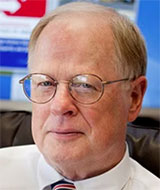
Jim Duderstadt
60th Reunion Book
University of Michigan President Emeritus James J. Duderstadt, who devoted his academic career to an institution he shaped with his zeal for technology, innovation, and equality, died Aug. 21 at age 81.
Duderstadt also held the title of University Professor of Science and Engineering, and was a former provost and dean of the College of Engineering.
Known as ”The Dude” to students and alumni, Duderstadt was the university’s 11th president from 1988-96 before stepping down to lead the Millennium Project, a research center focusing on the impact of societal, economic and technological changes on universities.
The Millennium Project is located on North Campus in the James and Anne Duderstadt Center, which was named in the Duderstadts’ honor in 2003. He also co-founded and, in its early years, co-directed U-M’s program in Science, Technology and Public Policy, and chaired the Michigan Energy Research Council coordinating energy research on the Ann Arbor campus.
“My interest has always been in building things — theories, projects. If you’re interested in building things, you eventually get interested in building organizations,” Duderstadt told an Ann Arbor News reporter in 1985.
His skill in leading one of the world’s great research universities was rooted in a simple Midwestern upbringing. Duderstadt was born Dec. 5, 1942, in Fort Madison, Iowa, and was raised in the small, German farming community of Carrollton, Missouri, where he was an all-A’s student, played varsity football, basketball and baseball, and was a member of the track team.
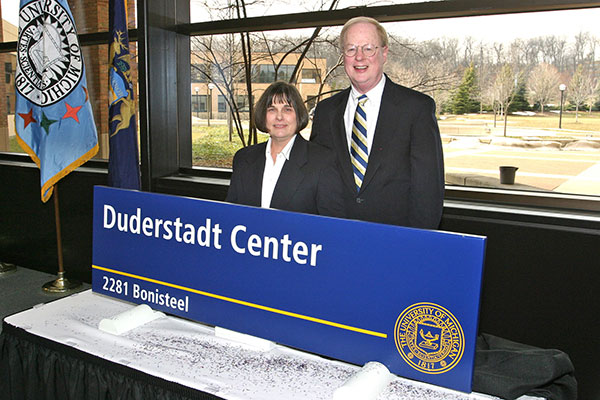
President Emeritus James J. Duderstadt and his wife, Anne, at the March 19, 2004, ceremony
celebrating the naming of the James and Anne Duderstadt Center
Duderstadt, 6 feet 4 inches tall and trimly built, played football in his freshman and sophomore years at Yale University, from which he graduated summa cum laude with a Bachelor of Engineering degree in electrical engineering in 1964. That same year, he married his high school sweetheart, Anne Marie Lock. Duderstadt always credited his wife as a strong partner during his tenure as president.
He earned two degrees from the California Institute of Technology: a Master of Science in engineering science in 1965 and Ph.D. in engineering science and physics in 1967. He also was an Atomic Energy Commission Postdoctoral Fellow at Caltech before joining the U-M faculty in 1969.
“James Duderstadt was a visionary, but even more, a trained engineer with the inspiration and energy to shape those visions into realities for the transformation and elevation of this university,” President Santa J. Ono said.
“He leaves behind a profound and lasting legacy, and we will always be grateful for his vision, his commitment and his transformative impact on the University of Michigan.”
Duderstadt received the College of Engineering’s Nuclear Engineering Teacher of the Year Award in 1969 and the Outstanding Teacher Award in 1980. His teaching and research interests were vast, and included diverse applications of physics and mathematics, nuclear systems, science policy, information technology, higher education policy and engineering education.
As College of Engineering dean, he oversaw an investment of approximately $70 million in new construction for facilities that allowed the college to fully establish itself on North Campus. Appointed in 1981, he was the youngest dean in CoE history and served until 1986.
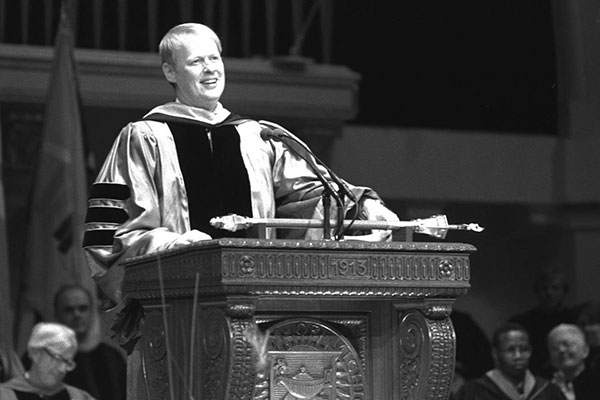
James J. Duderstadt addresses the audience at his inauguration
as the university’s 11th president on Oct. 6, 1988
Duderstadt, who was named provost and vice president for academic affairs in 1986, was decisive and believed that educated people could build and control their own futures. He outlined a strategic planning process that challenged the university community to anticipate the needs for higher education in the 21st century and map a strategy for meeting those needs. He predicted the future would be dominated by three crucial elements: knowledge, globalization and pluralism.
As president, he sought to strengthen U-M’s academic programs, diversify its student body and faculty, build strong private and federal support, rebuild facilities on U-M campuses and strengthen its leadership role in higher education.
Duderstadt demonstrated an unwavering commitment to diversity and equality in higher education. In his first State of the University address, he declared, “If we do not create a nation that mobilizes the talents of all of our citizens, we are destined for a diminished role in the global community, increased social turbulence, and we will, most tragically, have failed to fulfill the promise of democracy on which this nation was founded.”
He launched the Michigan Mandate, a strategic plan to make U-M a leader in building a multicultural community. The university more than doubled its number of students of color, from 11% to 25%; increased retention of students of color; doubled the number of underrepresented assistant professors of color promoted to the rank of associate professor; and nearly doubled the number of faculty of color in academic leadership and administrative positions.
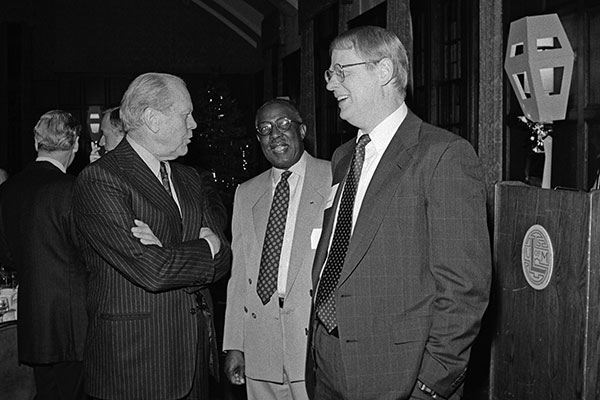
President Emeritus James J. Duderstadt (right) talks with former U.S. president and
U-M alumnus Gerald R. Ford (left) and Charles D. Moody Sr., vice provost emeritus
for minority affairs and professor emeritus of education, at a March 11, 2005, event
Duderstadt, the father of two daughters, also strengthened U-M’s commitment to gender equity with the Michigan Agenda for Women, a plan to promote the success of women students and employees of diverse backgrounds.
In 1996, U-M became the first public university to raise $1 billion in a fundraising campaign and the first to earn Wall Street’s Aa1 credit rating. Private giving nearly tripled during his administration, and the university’s endowment grew from $250 million to more than $1.6 billion, at the time the fourth-largest for a public university system.
A champion of technology and innovation, Duderstadt entertained visitors with real-time views of various campus construction projects from his second-floor office in the Fleming Administration Building at a time when webcams were a novelty. By the end of his presidency, U-M was close to completing a massive program to rebuild, renovate and update all its campus buildings, a $1.5 billion effort.
During his career, Duderstadt received many awards and honorary degrees for his research, teaching, and service activities. They include the E. O. Lawrence Award for excellence in nuclear research, the Arthur Holly Compton Prize for outstanding teaching, the National Medal of Technology for exemplary service to the nation, and the Vannevar Bush Award for lifelong contributions to the welfare of the nation through public service activities in science, technology, and public policy.
He was elected to the National Academy of Engineering, the American Academy of Arts and Science, Phi Beta Kappa and Tau Beta Pi.

President Emeritus James J. Duderstadt (center), President Emeritus Harold T. Shapiro (left),
and former president Lee C. Bollinger (right) were part of an April 6, 2017, panel discussion
marking the university’s bicentennial celebration
He chaired or served on several national study commissions examining federal science policy, higher education, information technology and energy sciences. These include the National Science Board; committees of the National Academies; the National Commission on the Future of Higher Education and the Nuclear Energy Advisory Committee of the Department of Energy
He also served on the boards of the Big Ten Athletic Conference, U-M Hospitals, Unisys and CMS Energy; chaired the Policy and Global Affairs Division of the National Research Council; co-directed the Glion Colloquium; was a nonresident Senior Fellow of the Brookings Institution; and chaired the board of directors of the U.S. Department of Energy’s Consortium for Advanced Simulation of Light Water Reactors Nuclear Energy Innovation Hub.
A prolific writer, Duderstadt authored 23 books, including “Intercollegiate Athletics and the American University, A University President’s Perspective,” which won the University Press Book Award in 2002.
Raising concerns about the dangers that college sports programs pose to higher education, he wrote: “Big-time college sports have threatened the integrity and reputation of our universities, exposing us to the hypocrisy, corruption, and scandal that all too frequently accompany activities driven primarily by commercial value and public visibility.”
Duderstadt offered controversial suggestions for reform, including eliminating athletic scholarships, reducing coaches’ salaries and limiting the length of sports schedules.
Duderstadt is survived by his wife, Anne; daughters Susan Kay (John Iskander) of Atlanta, and Katherine Anne (Nathan Schwadron) of Newton, Massachusetts; and grandchildren Eleanor Aida Iskander, Jonas Luca Iskander, Marina Anne Schwadron and Jane Maria Schwadron.
Remembrance, Howard Gillette ’64
September 9, 2024
Jim’s life was one of extraordinary achievements, not the least of which was his central role in boosting the University of Michigan to world-class status. Among the elements of that success, he was most proud of solidifying a program of affirmative action, not just for incoming students but also for faculty and staff.
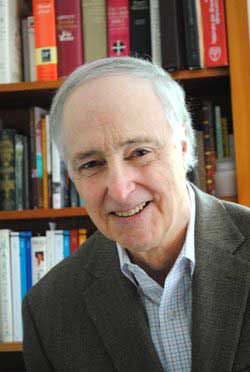
Howard Gillette
Professor of History Emeritus
Rutgers University-Camden
As he saw those advances decline in the years after his retirement, he remained committed to the goals of the program he called the Michigan Mandate. When the Supreme Court appeared prepared to end affirmative action nationally last year, I knew right away that he was the right person to anchor a class Zoom on the subject. I wanted Jim to speak from the heart, hopefully revealing some clue as to his commitment from his years at Yale. That didn’t happen directly because he was so anxious to inform us of what he had achieved. Originally losing sight of his ten-minute time limit, he was prepared to lay it all out in some 50 slides. Instead, he talked from notes. Sadly, Jim joined another panelist that day, Joe Lieberman, also now among our deceased classmates.
While I was sorry neither participant was as clear as I hoped about their links to the emerging civil-rights movement that touched so many of us as undergraduates and in our later years, the Zoom is worth watching as another reminder of how formidable our undergraduate years were in shaping our lives.
Essay, 60th Reunion Book
by Jim Duderstadt
May 2024
Bright College years, with pleasure rife,
The shortest, gladdest years of life;
How swiftly are ye gliding by!
Oh, why doth time so quickly fly?
The seasons come, the seasons go,
The earth is green or white with snow,
But time and change shall naught avail
To break the friendships formed at Yale.
In after years, should troubles rise
To cloud the blue of sunny skies,
How bright will seem, through mem’ry’s haze
Those happy, golden, bygone days!
Oh, let us strive that ever we
May let these words our watch-cry be,
Where’er upon life’s sea we sail:
“For God, for Country and for Yale!”
From the small town of Carrollton, Missouri (population 5,280), I applied to Yale as a favor to my socialite aunt from Kansas City. I thought Yale was one of those schools in England. I received a telegram from Bryce Jordan to play football. Having never seen a telegram and very impressed, I accepted the offer from Yale. I was met at the train station by Terry Holcomb, a friend for life and one of the treasures of Yale and the nation, as he served as development officer for many years. This was a very important friendship formed at Yale, as were many other friendships.
After almost flunking chemistry because of football practice, I quit football to concentrate on academics. Majoring in Electrical Engineering (because I was told that it was the hardest major), I found my career. I married a high-school classmate after graduation and spent the summer at Los Alamos, then headed to Pasadena for graduate school at Caltech. Majoring in Nuclear Engineering and Physics and acquiring two daughters, I completed a Ph.D. in record time because of the Vietnam War. Deferments resulted sequentially first because I was married, second because I had children, and third because I had worked at Los Alamos and was a security risk for the secrets I had learned.
On my way to Washington, DC to accept the Lawrence Award for my thesis, as a favor to my advisor I stopped by the University of Michigan Nuclear Engineering Department to give a lecture. As I was returning from Washington the chair of the department called my home and told my wife that they would like to offer me a job – she accepted. I have spent my entire career at Michigan. Going through the ranks of Assistant, Associate, full Professor, Dean of Engineering, Provost and Vice President for Academic Affairs, and President.
After 56 years at the University of Michigan, I will officially retire in September of 2024.
My life has been devoted to education. I believe that education for ALL is the only way to achieve the happiness and fulfillment for all citizens of the world.
I owe much to Yale for my life’s work. It was a great and inspiring education, with many lifelong friends. I also learned along the way that there are many great institutions of learning, from community colleges to the variety of small to mega colleges and universities to now, mainly because of COVID, online learning. Anyone with the will to learn and hard work can get a good education anywhere.
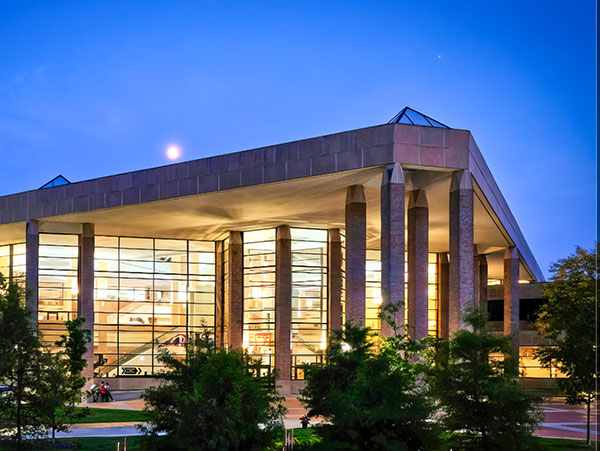
The James and Anne Duderstadt Center, aka “The Dude”
Essay, 50th Reunion Book
by Jim Duderstadt
May 2014
Most Yale classmates will find the past 50 years of my life both unusually stable and probably very boring. In 2014 my wife Anne and I will celebrate our 50th wedding anniversary. In 2017 when the Univ. of Michigan celebrates its bicentennial, I will complete my 50th year on its faculty. Anne and I have also lived only in Ann Arbor during that period. The same wife, same employer, same home for half a century.
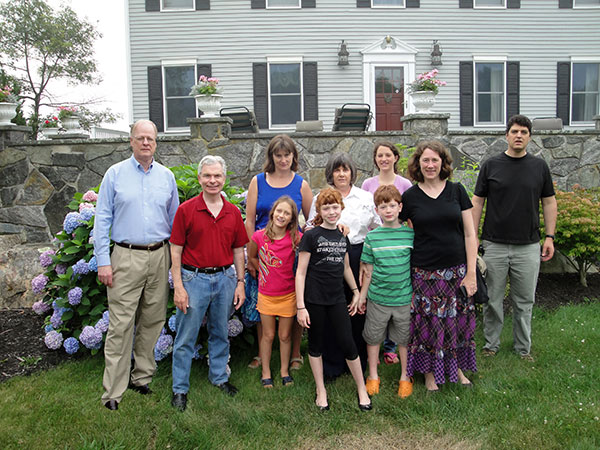
The entire Duderstadt clan
Yet, every five years or so, despite my mobility impairment, my actual activities have shifted quite dramatically. My early years after Yale (and then Caltech) were dominated by research on exotic projects such as nuclear rockets, thermonuclear fusion, and nuclear fission power, along with traditional faculty activities in teaching and faculty governance. But my academic career lasted only a decade, since I was quickly drawn into the vortex of academic administration, first as dean of engineering, then provost, and finally president of the university over the next twenty years. My activities shifted to hiring and firing, begging for dollars, and annoying distractions such as college sports (including several Rose Bowls, three Final Fours, and a couple of embarrassing scandals). Of course there were occasional triumphs (raising the reputation of the university, launching the effort to build and manage the Internet, and enhancing the diversity of the institution–although that landed me as a named defendant in the Supreme Court case of 2003). But as my years of university leadership ended, I faced the challenge of returning to academic life.
With little scientific talent left, I ended up as a professional 2x4, chairing various national and international bodies with the task of banging politicians and the public over the head to get them to understand scientific and technological issues (e.g., global climate change, cyberinfrastructure, research policy) sufficiently to avoid destroying the planet. Sometimes writing books goes with this territory, and of course, continuing to teach, although now in public policy rather than physics or engineering.
So this is where Yale comes in. Five decades ago during my college years, Yale was still insisting on a liberal arts education, even for those few of us enrolled in engineering in the old Sheffield Scientific School. Hence in addition to thermodynamics and quantum mechanics, I had to take courses from folks like John Morton Blum, Vincent Scully, and Chris Argyris and learn about political theory, literary criticism, psychology, etc., not to mention, of course, going to college with other students who were actually majoring in these foreign subjects!
So finally after a career of 50 years, only 20% of which has been solving equations or proving theorems, I now realize that these other courses and students from other majors were probably the most important part of my Yale education, aside from growing up.
Now if only I had another 50 years to convince my colleagues in science and engineering of my discovery of the value of the liberal arts!

